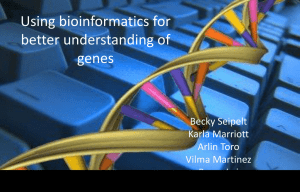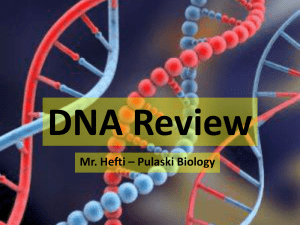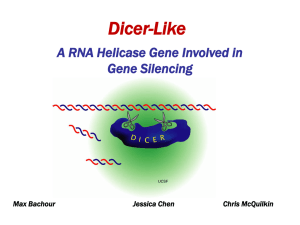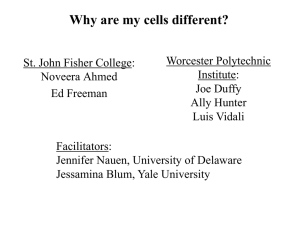ASM Project - the Biology Scholars Program Wiki
advertisement
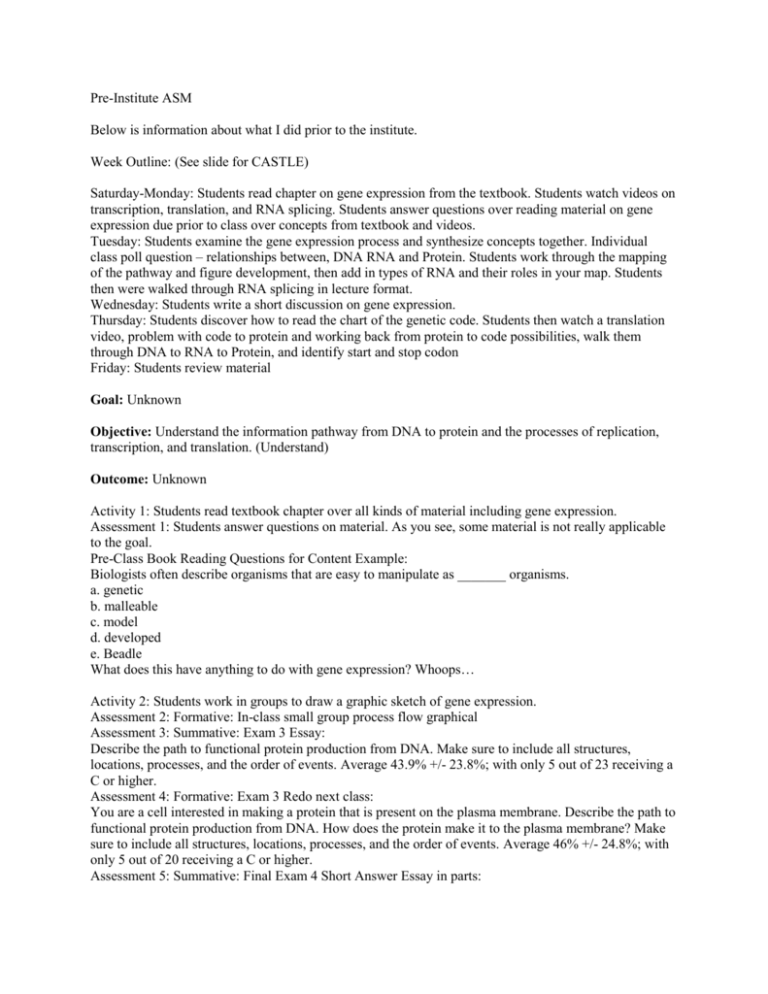
Pre-Institute ASM Below is information about what I did prior to the institute. Week Outline: (See slide for CASTLE) Saturday-Monday: Students read chapter on gene expression from the textbook. Students watch videos on transcription, translation, and RNA splicing. Students answer questions over reading material on gene expression due prior to class over concepts from textbook and videos. Tuesday: Students examine the gene expression process and synthesize concepts together. Individual class poll question – relationships between, DNA RNA and Protein. Students work through the mapping of the pathway and figure development, then add in types of RNA and their roles in your map. Students then were walked through RNA splicing in lecture format. Wednesday: Students write a short discussion on gene expression. Thursday: Students discover how to read the chart of the genetic code. Students then watch a translation video, problem with code to protein and working back from protein to code possibilities, walk them through DNA to RNA to Protein, and identify start and stop codon Friday: Students review material Goal: Unknown Objective: Understand the information pathway from DNA to protein and the processes of replication, transcription, and translation. (Understand) Outcome: Unknown Activity 1: Students read textbook chapter over all kinds of material including gene expression. Assessment 1: Students answer questions on material. As you see, some material is not really applicable to the goal. Pre-Class Book Reading Questions for Content Example: Biologists often describe organisms that are easy to manipulate as _______ organisms. a. genetic b. malleable c. model d. developed e. Beadle What does this have anything to do with gene expression? Whoops… Activity 2: Students work in groups to draw a graphic sketch of gene expression. Assessment 2: Formative: In-class small group process flow graphical Assessment 3: Summative: Exam 3 Essay: Describe the path to functional protein production from DNA. Make sure to include all structures, locations, processes, and the order of events. Average 43.9% +/- 23.8%; with only 5 out of 23 receiving a C or higher. Assessment 4: Formative: Exam 3 Redo next class: You are a cell interested in making a protein that is present on the plasma membrane. Describe the path to functional protein production from DNA. How does the protein make it to the plasma membrane? Make sure to include all structures, locations, processes, and the order of events. Average 46% +/- 24.8%; with only 5 out of 20 receiving a C or higher. Assessment 5: Summative: Final Exam 4 Short Answer Essay in parts: Breast cancer is often triggered by overexpression of the proto-oncogene HER2 receptor on the surface of the epithelial cell. This receptor then binds growth factors and triggers cancerous cell growth. Answer the following questions/parts to show how the HER2 receptor is produced at high levels in cell. To answer this question you will follow DNA and its transformation to HER2 protein receptor and how it ends up on the plasma membrane in epithelial cells. Answer by filling in the blanks or answering with short sentences. A. DNA is found where in this cell? B. This DNA is converted into RNA through the process of _________. Where does this occur? C. This RNA is then spliced, removing the ____________ and splicing together the ___________. Then this RNA adds to it a ____________ and a ______________. This new RNA is called _________________. D. What happens to the 'new RNA' after step C? E. Where and when does translation take place? F. Translation involves the use of tRNA. tRNA brings __________ to the location of translation. tRNA also binds with its anti-codon to what molecule? What happens at the location of translation after synthesis of the HER2 protein? G. What happens immediately to the HER2 protein after it's amino acid sequence is made to form a fully functional HER2 protein? H. Describe the process by which the HER2 protein makes its way from the "location of translation" to the plasma membrane. Make sure to include the correct order of organelles and proteins involved. Some students improved their scores (13 out of 23). The mean for this question was 52.5% +/- 36.6%; with 9 out of 24 receiving a C or higher. Student’s t-test revealed p-values for all comparisons to be >0.05 (0.77, 0.34, 0.50) and thus not significant. It was apparent that the students either knew the material or did not by the final, with those receiving a C or higher acquiring an average (mean) of 96.7% +/- 13.1% and those receiving a D or lower average (mean) of 26.0% +/- 5.6%. Need to identify what is preventing the lower performing students from understanding this critical course concept. Clearly, I am not preparing my students well for higher level learning. It is for these reasons above that this institute was valuable. Below are my modifications that I made for this important topic in my course. ASM Institute Product Goal: Critically examine the structure of cells and how molecular pathways mold these structures for overall cellular function. (Understand, Analyze) Objective: Structure the roles of gene expression and implement these roles in terms of cellular function. (Apply, Analyze) Outcome 1: Integrate the plan of action in a cell to make a protein which applies a new function for the cell. (Analyze) (BIB: Information flow, exchange, and storage – structure & function) (Highlighted in Presentation GRID and CASTLE) Activity 1: Students read chapter on gene expression from the textbook. Students watch videos on transcription and translation. Assessment 1: Formative; Students individually answer questions over reading material on gene expression due prior to class over concepts from textbook and videos. One question should include the Central Dogma. (Remember) Activity 2: Students individually use a strip sequence of gene expression steps and major components and organize the steps and components. Students enter into small groups and talk about their order of strips. Students in groups then create a sketch of gene expression within a cell of their choosing. Assessment 2: Formative; Students get individual feedback from fellow students on the flow of information. Students get group feedback from instructor on flow of information and graphical sketches (Understand) Assessment 3: Formative; Exit Poll with (1) a question to see if students can summarize the flow of information (Understand) and (2) a question to see if students can infer what would happen if a modification occurred at a certain part of the process (Apply) and (3) a question to demonstrating level of comfort with the flow of information. Activity 3: Students re-examine the application question from the Exit Poll Assessment in small groups and come to a consensus on their solution. Groups present graphical sketches of solution. Assessment 4: Formative; Students get group feedback on their graphical sketches from instructor on their information flow and manipulation. (Apply) Assessment 1 Example Question: 1. The template in transcription is: a. a primer. b. an enzyme. c. a strand of DNA. d. a strand of RNA. e. ribonucleoside triphosphates. 2. Which of the following processes would be first to occur in the process of gene expression? a. transcription b. translation c. replication d. protein folding e. RNA splicing Assessment 3 Example Questions: 1. Describe the role of RNA Polymerase in terms of Gene Expression? 2. What would happen if the active tRNA were not function properly? Describe how the system of gene expression will be modified? 3. Indicate your level of comfort in understanding the flow of information during the process of gene expression. 5 – Very comfortable. 4 – Somewhat comfortable. 3 – Neither comfortable nor uncomfortable. 2 – Somewhat uncomfortable. 1 – Uncomfortable. 4. Based upon your answer above, what part of gene expression are you having the most trouble with implementing? Assessment 4 Example Question: 1. Once a protein is made it has a function in the cell. One protein, called YAP, functions in the nucleus to promote growth of a cell. However, YAP protein relies on gene expression in order to be made to help promote cell growth. Demonstrate in a graphical sketch what would happen to the gene expression of YAP and consequently cell growth if RNA Polymerase was activated at the transcription start site for the YAP gene. Outcome 2: Integrate a plan of action in a cell to coordinate the movement of a protein which applies a new function for the cell. (Analyze) (BIB: Information flow, exchange, and storage – structure & function) Activity 1: Students read chapter material on protein folding (previously covered in course) and transport from the textbook. Students watch videos on protein folding and transport. Assessment 1: Formative; Students individually answer questions over reading material on gene expression due prior to class over concepts from textbook and videos. One question should include the transport of proteins via vesicles. (Remember) Activity 2: Students individually work using strip sequences to order the steps and content into the proper order. Entire group comes to a consensus on the order. Every group has a slightly different protein that they are moving and a different location. JIGSAW to allow students to learn about all the different ways that proteins move. Students then collaborate in their new group to examine why certain proteins need to be in certain places in the cell. Assessment 2: Formative; Student groups will be given feedback by the instructor on their order of events and major players in protein transport. (Understand) Activity 3: Students individually pick their favorite one of the pathways from the JIGSAW and problem solve what would happen to the transport pathway when a drug is used to block microtubule formation. Students work individually to form a graphical sketch of the implications of their transport pathway. Assessment 3: Formative; Students will submit their graphical sketch of their transport pathway and will be evaluated for the correct order of events and what process is halted in this process. (Apply) Outcome 3: Design a plan of action in a cell to make and move a protein in the cell which applies a new function for the cell. (Create) (BIB: Information flow, exchange, and storage – structure & function) Activity 1: Walk students through what happens when a cell needs to respond to an environmental stimuli for the purpose of creating and moving a specific protein. Assessment 1: Formative; Students will be evaluated for understanding of steps using immediate response questions. When there is major confusion, students will share with a peer about what is the correct step. (Understand) Activity 2: Students work in groups to research a protein that has not been used in class thus far and research (1) what cell internal or cell external force promotes its production, (2) where it is transported when active, (3) what is the function of the protein at its final location? Assessment 2: Formative; Groups of students will be given immediate feedback from instructor on their desired protein and whether they have the correct function and where it is transported. Activity 3: Students are then asked to create a design of a cell and the process with all the steps of what happens if that protein is stimulated to be made and transported to the location of activity as was discovered through their research. Assessment 3: Students will turn in their design as a final evaluation of how and why a protein is made in the cell. (Create) Activity 4: Students will receive their design back and will work as a group to modify and correct the plan. Once their plan is in place, students will receive a situation where a protein in the pathway is mutated and asked to modify their pathway to distinguish what would happen. Assessment 4: Formative; Student groups will turn in their revised product that will be evaluated for coming up with an appropriate plan (Analyze) Assessment 5: Summative; Student groups will implement investigate what happens when a receptor protein is stimulated to be produced and trafficked to the plasma membrane to perform a specific function. (Apply)


